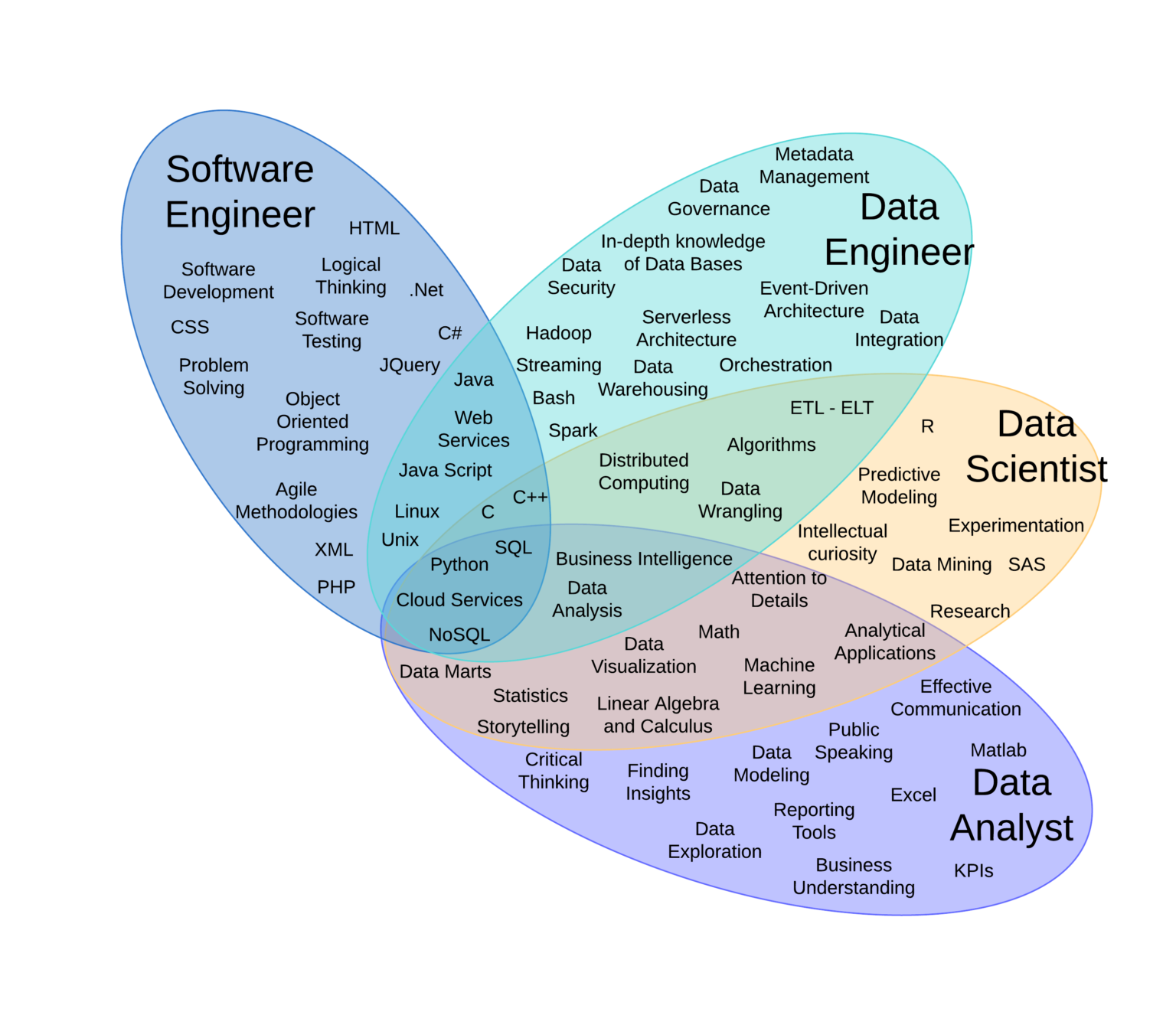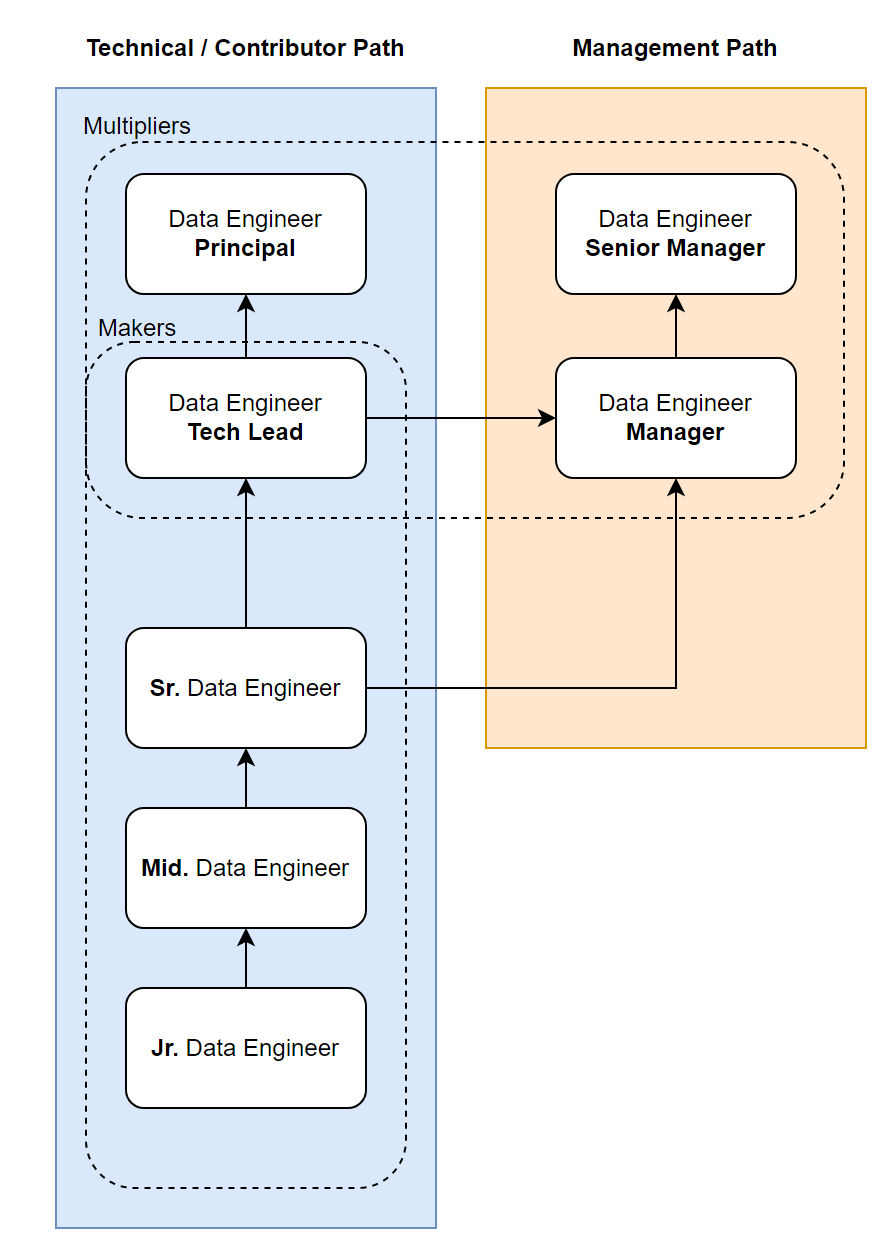The Data Engineer
My personal take on how to define a data engineer.
Context
To better understand the profile of the data-engineer, we first need to assess the digital-evolution of the company. We usually see the following patterns:
Phase 0: The company operates outside the digital realm (paper books, lack of formal or integrated systems).
Phase 1 (digitalization strategy): The end-goal of this phase is to represent the business operation as processes that are managed by a software or at least leave a digital paper trail in the system.
- Stage 0: Only accounting data is on digital form (e.g., payments, wire transfers, fund disbursement).
- Stage 1: The company is able to measure and capture the output and/or productivity of their business units (e.g., digital spreadsheets).
- Stage 2: The company can model their business processes in software (e.g., flow diagrams, bizagi). Most processes already leave a reliable “papertrail” of their operations in the digital realm.
- Stage 3: The company builds and integrates proprietary software into their business operations. The integration is cross-company. At this stage, the software is usually the “source of truth” (OLTP).
Phase 2 (data strategy): the end-goal of this streategy it to allow the company to derive value from data and incoporate a data-driven mindset into the decision making.
- Stage 0: Data infrastructure groundwork by data-architects and data-engineers. The end-goal is to build a data platform (OLAP) to enable advanced reporting and analytics.
- Stage 1: The company can use the data platform to understand the current status of the business (descriptive analytics).
- Stage 2: The company is able to use the data platform to understand the future path of the company under different scenarios (predictive analytics).
- Stage 3: The company is able to take proactive action into shaping their desired future outcome (prescriptive analytics).
A data-engineer can get involved starting into the Phase 1: Stage 2 all the way into the final stages of the data strategy (Phase 2: Stage 3).
Profile Specification
A data engineer takes the fundamentals of a software engineer and specializes them into the data-domain. These profiles are usually in charge of designing, implementing, and maintaining the data architecture of your company. The most common use cases are:
- Contribute to the optimization of the data models in the transactional environment.
- Design, implement, and maintain the data platform (OLPA infra).
- Build tailored data-models for analytical purposes.
- Support the data science and machine learning teams with model productivization or feature preprocessing pipelines.
For a complementary definition of a data engineer in relation with other data roles, I highly recommend taking a look into the “Data Roles” post by Wizeline (reference here).

Career Path
The data engineers usually follow a traditional software engineer career path. We commonly have a technical individual contributor path with at least 3 basic seniority levels (junior, mid, senior) and 2 advanced levels that can be:
- Tech-oriented: Tech lead, principal engineer, etc.
- People-oriented: Manager, director, etc.


Proeficiency Assessment
The seniority assessment evaluation is an evidence-based methodology that attempts to aproximate the corresponding seniority-level for a given candidate.
[TS-GSEE] Tech Skills - General Software Engineering Exposure
| Reference | Description |
|---|---|
TS01 |
Advanced coding proficiency level in at least one programming language: Python, Scala, Rust, etc. |
TS02 |
Promoter of coding best practices: documentation, unit testing, types, etc. |
TS03 |
Working knowledge about packaging and distribution of source code with dependency management (e.g., code versioning, packaging, virtualenv, docker). |
TS04 |
Familiarity with version control (Git), development environments, and CI/CD tools (e.g., Github Actions, Jenkins). |
TS05 |
Deep working understanding of funuctional and object-oriented programming paradigms. |
TS06 |
Usage of coding design patterns to implement different abstraction levels on a technical solution. |
TS07 |
Relevant experience in at least one cloud computing provider: AWS, GCP, Azure, etc. |
[TS-DEDE] Tech Skills - Data Engineering Domain Expertese
| Reference | Description |
|---|---|
TS08 |
Advanced SQL proficiency level. |
TS09 |
Working understanding about the different designs and needs of the OLTP & OLAP environments. |
TS10 |
Relevant experience desinging and implementing data pipelines in at least one paradigm: batch-oriented, streaming, or event-based. |
TS11 |
Thorough understanding and ability to implement best practices in ETL/ELT design. |
TS12 |
Ability to implement efficient solutions leveraging the following concepts when needed: concurrent, parallel, and/or distributed processing. |
TS13 |
Familiar with advanced orchestration software (e.g., Airflow, Prefect, Dagster, etc). |
TS14 |
Experience working with relational (e.g., MySQL, Postgresql, etc) and no-sql databases (e.g., MongoDB, Cassandra, ElasticSearch, etc). |
TS15 |
Experience working with other popular data-stores (e.g., Redis, Memcache, RabbitMQ) |
TS16 |
Experience working with at last one analytical databases/datastores such as Unity Catalog, Snowflake, PrestoDB, TrinoDB, etc. |
TS17 |
Experience designing and implementing a data lake or data lakehouse solution (e.g., bronze, silver, gold layers, data storage formats, etc). |
TS18 |
Experience designing and implementing efficient a data warehouse (e.g., data modeling for business needs). |
TS19 |
Proficiency on optimizing transactional data models to improve performance. |
[SS-PEPS] Soft Skills - Planning, Execution, and Problem Solving
TBD
[SS-IVBI] Soft Skills - Innovation, Value, and Business Impact
TBD
Highly-Effective Team Composition
TBD
